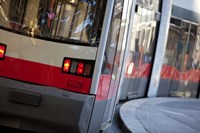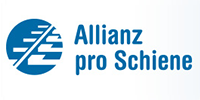
In the latest comparison of transport modes carried out by the German Pro-Rail Alliance and the ACV (Automobile-Club Transport) the railways have maintained their commanding lead as the safest mode of transport.
The figures show that in the ten years from 2006 to 2015, the fatality risk for car occupants was 75 times higher than for rail passengers. When it comes to injury risk, the gap between the transport modes was even bigger: measured in passenger-kilometres, the risk of injury on a car journey is 127 times higher than on a train. Whereas buses are also much safer than cars, the gap between buses and trains has continued to increase: the fatality risk for bus passengers is six times higher than for rail travellers, and the injury risk is 41 times higher than on the railways. “For everyday mobility, the railways are by far the safest mode of transport,” said Dirk Flege, managing director of the Pro-Rail Alliance, at a joint press conference with ACV on Tuesday in Berlin.
Comparison of transport modes: Germany is better than the European average
In a Europe-wide comparison, the figures also speak clearly: nowhere in Europe is travelling by car safer than by train. On transport safety, Germany ranks highly for both rail travel and car transport. The European average number of fatally injured car occupants for the years 2005 to 2014 was 3.4 per one billion passenger-kilometres. In Germany, that figure was 2.4 car occupants. This compares with the European average of 0.14 fatally injured rail passengers. The comparison of transport modes shows that with 0.03 fatally injured passengers, the railways in Germany were considerably better than the European average. “Rail travel is safer than car travel in all European countries,” said the Pro-Rail Alliance managing director. The most dangerous countries for car drivers are in eastern Europe: Rumania (average 13.2 deaths per billion passenger-kilometres), Latvia (9.7) and Poland (9.3) have the highest number of fatally injured car occupants to mourn.
Road traffic casualties: no reason to celebrate
- Transport safety targets: Germany not in the target range
- Road accident fatalities: 2010=100% Germany -10%, France -13%, EU 28 -17%, Poland -25%
- German government target: 40% fewer fatalities compared with 2010
Horst Metzler, managing director of the ACV, calculated that the overall number of road accident fatalities in 2016 fell once again after rising in the previous two years. “With an estimated 3,300 deaths in Germany in 2016, an increasing number of seriously injured people and around 26,100 fatalities across Europe in 2016, there is no reason to celebrate the historically low figure,” said Metzler. “Road transport across Europe wipes out the equivalent of small town every single year”. The German government’s own target of cutting the number of road transport deaths by 40 percent by 2020 “is currently light years out of reach,” said Metzler. Referring to the Federal State Index on Mobility and Environment, he added: “Only one of the 16 German federal states is currently within the target range for accident casualties. We have to make an additional effort on transport safety to ensure that Germany’s Vision Zero target does not lose credibility,” said Metzler.
Safety: growing number of HGVs undermining targets
The transport organisations agreed that the growing number of heavy goods vehicles in Germany is undermining efforts to increase safety on the roads. The Pro-Rail Alliance managing director said calculations based on a direct comparison of transport modes show that rail freight transport is 42 times safer than HGVs when transporting dangerous goods. However, politicians are still continuing to back road freight transport. The ACV complained that when key policy decisions on freight transport are taken, the safety of car drivers is glossed over. “Currently, HGVs are involved in one in five fatal accidents,” said Metzler. “Longer HGVs, the so-called Gigaliners, will not reduce HGV traffic, and they will lead to new safety risks, for example when overtaking,” warned Metzler. “Experts reckon that allowing longer HGVs to operate without restrictions from the first of January will mean 7,000 additional HGVs journeys per day,” said Metzler. “More HGVs in Germany is not just bad for the environment; it is also bad news for car drivers.”
Longer HGVs: final report lists additional risks
Metzler cited additional infrastructure problems and safety risks relating to the impact of longer HGVs on road transport, which were listed in the final report on by the Federal Highway Research Institute for the Federal Transport Ministry:
- Increased fire load in tunnels
- Emergency stopping bays in tunnels are too short
- Lack of suitable parking bays at motorway services
- The danger to pedestrians and cyclists
- Overtaking longer HGVs on rural roads must be examined further
“As an automobile club we cannot understand, given all the concerns that are explicitly listed in the final report on longer HGVs, why they are being allowed to operate regularly without any further discussion on safety issues.” The managing director of the Pro-Rail Alliance pointed out that the final report completely left out the issue of longer HGVs using level rail crossings. Extensive upgrades are required so that longer HGVs can safely cross the barriers. “Anyone who takes road safety seriously must call for more discussion on longer vehicles.”
About Allianz pro Schiene
Allianz pro Schiene e.V. (The Pro-Rail Alliance) is the German alliance for the promotion of environmentally friendly and safe rail transport. It is an independent umbrella organisation that unites non-profit organisations and the commercial sector for the purpose of lobbying on behalf of the railways.




Comments
There are no comments yet for this item
Join the discussion